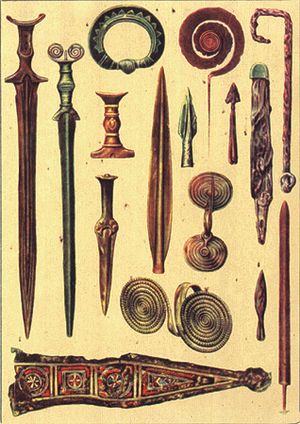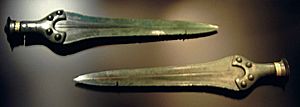History of the sword facts for kids
Swords have been super important throughout history! They weren't just used for fighting; they also played a big part in old traditions, myths, and even burial ceremonies. Think of them as more than just a weapon – they were symbols of power, honor, and sometimes even magic!
Contents
Swords Through Time
Let's take a journey through history to see how swords changed and what big moments they were part of. This timeline will help us understand their amazing story.
Bronze Age Swords
The very first long swords, about 60 centimeters (2 feet) or more, appeared around 1700 BC. This was during the Bronze Age, in places near the Black Sea and the Aegean Sea. Before this, people mostly used shorter weapons like daggers.
Making a good bronze sword was tricky! It needed the right mix of metals (an alloy), the perfect shape, and special heating and cooling steps. A long sword had to be strong enough to cut, flexible enough not to break easily, and tough enough to handle hard hits in battle.
Here's how they made them:
- Bronze was poured into molds to get the basic shape.
- Then, the swords were heated and cooled slowly.
- Finally, they were hammered when cold (called "cold hammering") to make them even harder and stronger.
Here are some cool facts about early swords:
- Around 1275 BC: An Assyrian sword was found with special writings on it.
- Around 450 BC: The historian Herodotus wrote about iron swords found in the tombs of Scythians. These swords were seen as symbols of the god Ares (Mars).
- 326 BC: During the Battle of the Hydaspes River, Alexander the Great defeated King Porus. Alexander was so impressed by "Indian steel" (called wootz steel) that he took about 10 kg of it!
- Around 230 BC: Philo of Byzantium wrote about how flexible the swords of the Celts and Iberians were in ancient Spain. They could bend like a spring without breaking, which suggests they might have used a special kind of steel.
- 216 BC: At the Battle of Cannae, the historian Polybius described the swords used by the Iberians (good for both cutting and stabbing) and the Gauls (mostly for cutting).
- 197 BC: The Romans defeated the Gauls near the River Clusius. Even though the Gauls had more fighters, their swords would bend after the first hit, and they had to straighten them! The Romans used this weakness to win.
- Around 20 BC: The Greek historian Diodorus Siculus wrote about the amazing quality of Celtiberian swords and how they were made.
- Around 5 BC: The poet Gratio Falisco mentioned the famous knives from Toledo, Spain, in his poem.
Swords in the Christian Era
Middle Ages Swords
The Middle Ages were a time of knights, castles, and, of course, swords!
- Around 500 AD: A shipwreck near Denmark was found with many "pattern-welded" swords. These swords were made by twisting and hammering different types of steel together, creating cool patterns and making them very strong.
- 796 AD: The emperor Charlemagne gave a sword made by the Huns to King Offa of Mercia. It was a valuable war prize.
- Around 850 AD: Al-Kindi described the famous Damascus swords, known for their unique patterns and sharpness.
- Around 900 AD: The first written records of the katana, the famous Japanese sword, appeared.
- 966 AD: An embassy from Borrell II gave 100 "Frankish swords" as a gift. These swords were very famous and feared!
- 1233 AD: James I of Aragon mentioned his sword, called "Tiso," during the siege of Burriana.
- 1248 AD: King Ferdinand III of Castile owned a famous sword called "Lobera."
- 1392 AD: Ibn Hudhayl wrote about two types of high-quality swords: those from Indian steel and those from the Franks (Catalan). He said the Frankish swords were so good they seemed to be made by "geniuses."
- 1425 AD: Sword makers in Valencia asked for their rules and traditions to be confirmed, just like those of the sword makers in Barcelona.
- 1474 AD: Jaime Pons, a fencing teacher from Majorca, wrote a book about fencing that was published in Perpignan.
Swords from 1500 to 1950
Swords continued to be important even as firearms became more common.
- 1509: When Catherine of Aragon married Henry VIII, swords from the armor factory in Zaragoza were given to the English king as a gift.
- 1517: During the conquest of Florida, swords proved to be very effective weapons for the Spanish conquistadors against the Native Americans.
- 1522: Ignacio de Loyola offered his sword to the Virgin of Montserrat.
- 1525: At the Battle of Pavia, King Francis I of France fought with a sword made by Joan Aldana from Tortosa.
- 1540: Vannoccio Biringuccio wrote "Pirotechnia," a book that talked about iron mines and how metal was made in a forge.
- Around 1541: Francisco Pizarro owned a sword made in Valencia by the armorer Mateo Duarte.
- 1544: Henry VIII had a hunting saber decorated by Diego Çaias.
- 1761: The "White Weapons Factory of Toledo" was created in Spain by King Carlos III. It was run by Lluis Calisto, a master sword maker from Valencia.
- 1772: Henry Nock, who founded a gun-making company, passed his business to James Wilkinson, who became famous for making swords and sabers.
- 1782: William Bowles wrote a book about Spain's natural history, which included information on how swords were made there.
- 1793-1795: During the "Great War" (which was a series of conflicts in Europe), weapon workshops in Catalonia reopened to make more swords.
- 1798: Ignacio Jordán wrote about the history of Aragon's economy and mentioned the sword makers of Zaragoza.
- 1804: James Wilkinson continued his famous sword-making business.
- 1844: Henry Wilkinson continued the family tradition of making high-quality swords.
- 1943: The Sword of Stalingrad was a jeweled ceremonial sword given by King George VI of the United Kingdom to the citizens of Stalingrad (now Volgograd) to honor their bravery during World War II.
Images for kids
-
The sword of Francis I of France, on display in Paris. It was made in Valencia by Antonivs.
See also
 In Spanish: Historia de la espada para niños
In Spanish: Historia de la espada para niños







